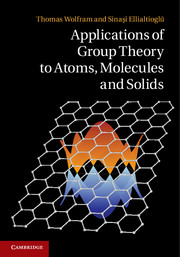Book contents
- Frontmatter
- Contents
- Preface
- 1 Introductory example: Squarene
- 2 Molecular vibrations of isotopically substituted AB2 molecules
- 3 Spherical symmetry and the full rotation group
- 4 Crystal-field theory
- 5 Electron spin and angular momentum
- 6 Molecular electronic structure: The LCAO model
- 7 Electronic states of diatomic molecules
- 8 Transition-metal complexes
- 9 Space groups and crystalline solids
- 10 Application of space-group theory: Energy bands for the perovskite structure
- 11 Applications of space-group theory: Lattice vibration
- 12 Time reversal and magnetic groups
- 13 Graphene
- 14 Carbon nanotubes
- Appendix A Vectors and matrices
- Appendix B Basics of point-group theory
- Appendix C Character tables for point groups
- Appendix D Tensors, vectors, and equivalent electrons
- Appendix E The octahedral group, O and Oh
- Appendix F The tetrahedral group, Td
- Appendix G Identifying point groups
- Index
- References
4 - Crystal-field theory
Published online by Cambridge University Press: 18 December 2013
- Frontmatter
- Contents
- Preface
- 1 Introductory example: Squarene
- 2 Molecular vibrations of isotopically substituted AB2 molecules
- 3 Spherical symmetry and the full rotation group
- 4 Crystal-field theory
- 5 Electron spin and angular momentum
- 6 Molecular electronic structure: The LCAO model
- 7 Electronic states of diatomic molecules
- 8 Transition-metal complexes
- 9 Space groups and crystalline solids
- 10 Application of space-group theory: Energy bands for the perovskite structure
- 11 Applications of space-group theory: Lattice vibration
- 12 Time reversal and magnetic groups
- 13 Graphene
- 14 Carbon nanotubes
- Appendix A Vectors and matrices
- Appendix B Basics of point-group theory
- Appendix C Character tables for point groups
- Appendix D Tensors, vectors, and equivalent electrons
- Appendix E The octahedral group, O and Oh
- Appendix F The tetrahedral group, Td
- Appendix G Identifying point groups
- Index
- References
Summary
Splitting of d-orbital degeneracy by a crystal field
As we saw in the previous chapter the s- and p-orbital degeneracies are unaffected when an atom or ion is placed in a site of octahedral symmetry. On the other hand, the d-and f-orbital degeneracies are changed. Transition metal ions of Ti, Fe, Ni, and Co, for example, have 3d electrons in their outer unfilled shells and exist as positively charged ions in solids and molecular complexes. Most frequently, the transition metal ion is coordinated with six neighboring ligands at a site of octahedral symmetry. The second most common situation is tetrahedral coordination with four neighboring ligands. Many of these transition metal solids and molecular complexes are colored and many are magnetic. The colors are attributed to vibronic (electronic plus vibration) transitions between the d-orbital groups that are split in energy by the non-spherical potential of the ligands. When the ligand orbitals are included in determining the splitting, the procedure is called ligand-field theory. Splitting due to adjacent ligands is discussed in Chapter 6.
Crystal-field theory was developed by Bethe [4.1] and Van Vleck [4.2] to explain the optical spectra of transition metal complexes and to understand their magnetic properties. In its simplest form the crystal-field model represents the ligands surrounding a metal ion as point charges that interact with the transition metal ion only through an electrostatic potential.
Information
- Type
- Chapter
- Information
- Applications of Group Theory to Atoms, Molecules, and Solids , pp. 90 - 122Publisher: Cambridge University PressPrint publication year: 2014
